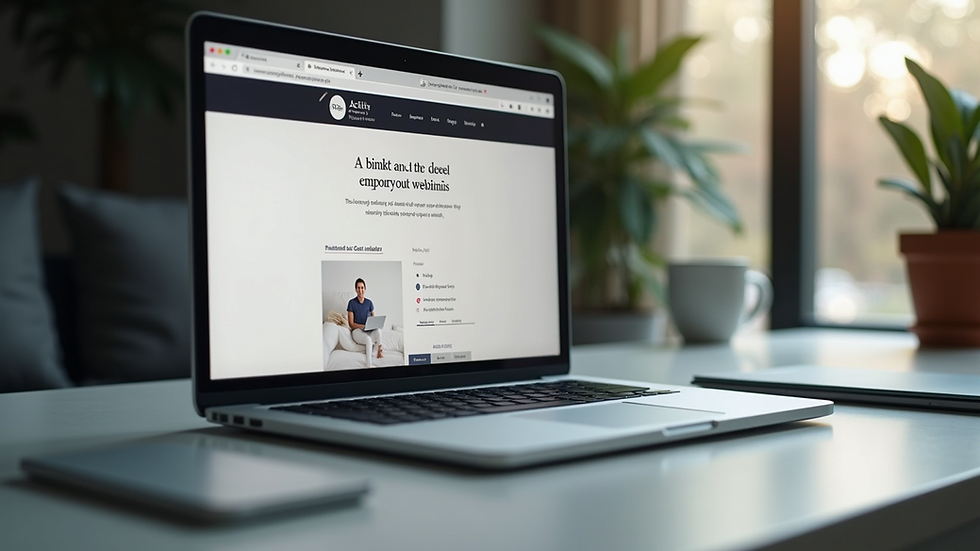Silicon Valley's Leading Web Design Trends and Tips
- Donald W. Carroll
- Jul 19
- 4 min read
When it comes to web design, few places epitomize innovation and excellence like Silicon Valley. Known as the epicenter of technology and startups, Silicon Valley continues to influence design trends and set the standard for how websites should look and function. In this blog post, we’ll explore the leading web design trends emerging from this tech powerhouse and provide practical tips to help you stay ahead of the curve.
Web Design Silicon Valley: The Evolution of User Experience
User experience (UX) is at the heart of modern web design. In Silicon Valley, companies understand that a seamless and enjoyable user experience is critical to retaining visitors and converting them into customers. According to studies, about 70% of consumers abandon a website due to poor user experience.
To enhance UX, designers are focusing on user-centric design principles. This means considering the user's journey from the moment they land on the site to when they complete a desired action. Essential elements like speed, navigation, and layout are carefully crafted to meet user needs.
For example, companies are utilizing tools like A/B testing to determine the most effective design choices. By comparing two versions of a webpage, designers can make data-driven decisions that optimize user engagement. Implementing clear calls-to-action (CTAs) is another crucial strategy. A well-placed and visually appealing CTA can significantly increase conversion rates.

Embracing Minimalism
In a world where distraction is ever-present, minimalism has emerged as a leading design trend in Silicon Valley. By stripping away unnecessary elements, minimalistic design principles promote clarity and simplicity. This includes using ample white space, limited color palettes, and straightforward typography.
Silicon Valley designs often use minimalism to draw attention to essential content. For instance, tech giants like Apple exemplify how less is often more. Their website largely uses clean lines, simple colors, and high-quality images to focus on product features without overwhelming the user.
Additionally, minimalism can enhance website performance. Fewer design elements mean faster load times, contributing to a better overall user experience. Studies have shown that users are more likely to stay on a webpage if it loads within two seconds. Hence, embracing minimalistic designs is not just about aesthetics—it’s a functional choice too.

The Rise of Dynamic and Interactive Elements
Silicon Valley web design is increasingly incorporating dynamic and interactive elements to engage users. Features such as animations, hover effects, and responsive design provide an immersive experience that captivates visitors.
Interactive designs not only entertain but also educate users about products and services. For example, a tech company might include an interactive demo that allows potential customers to explore features directly on their site. This approach enriches the user experience and often leads to higher retention rates.
Furthermore, incorporating video backgrounds and animated graphics can convey complex information quickly. It is essential, however, to ensure that these elements do not compromise site speed. Balancing active design with performance is crucial in maintaining usability.
Mobile-First Approach: Prioritizing Design for Mobile Users
As mobile device usage continues to expand, adopting a mobile-first strategy is essential. Statistics indicate that over half of all web traffic comes from mobile devices. Therefore, it is no surprise that many companies in Silicon Valley are prioritizing mobile design.
The mobile-first approach means designing websites primarily for mobile users before adapting them for larger screens. This includes ensuring that buttons are easy to click, images scale correctly, and content is organized for quick consumption. A responsive design that adapts to various devices enhances user experience and accessibility.
In practice, companies often test their websites on multiple devices during the design process to ensure optimal functionality across platforms. Mobile optimization not only improves user satisfaction but also plays a significant role in search engine ranking. Google has placed a strong emphasis on mobile-friendliness in its search algorithms.

Prioritizing Accessibility
In Silicon Valley, inclusive design is gaining momentum, with an increased focus on web accessibility. The goal is to create websites that everyone, including individuals with disabilities, can use comfortably. As awareness grows, companies are investing in technologies that enhance accessibility.
Web accessibility includes using alt text for images, ensuring proper color contrast, and allowing keyboard navigation. By adhering to Web Content Accessibility Guidelines (WCAG), designers create websites that are usable for the broadest audience possible.
Statistics show that over 15% of the world's population lives with some form of disability. Neglecting accessibility means excluding a significant portion of potential customers. From both ethical and business perspectives, making websites accessible is a vital consideration.
Future Trends in Web Design
As technology advances, the future of web design will continue to evolve. Emerging trends include the integration of artificial intelligence (AI) into web design processes. AI can analyze user behavior, enhancing personalization and streamlining design decisions.
Moreover, voice search optimization is becoming increasingly essential. As smart speakers gain popularity, optimizing websites for voice queries will ensure that businesses remain relevant in a changing digital landscape.
Lastly, the use of augmented reality (AR) and virtual reality (VR) in web design is likely to transform user experiences. These technologies provide immersive environments that allow users to interact with products and services in inventive ways.
In conclusion, staying updated on the latest web design trends from Silicon Valley can significantly enhance your online presence. By prioritizing user experience, embracing minimalism, implementing dynamic elements, adopting a mobile-first approach, and promoting accessibility, you can create a website that not only looks good but also functions effectively. Adapting to future trends allows you to remain competitive and relevant in an ever-evolving digital landscape.
If you are looking to learn more or need assistance with your web design project, you can explore silicon valley web design. Their innovative solutions can help you elevate your online presence to new heights.




Comments